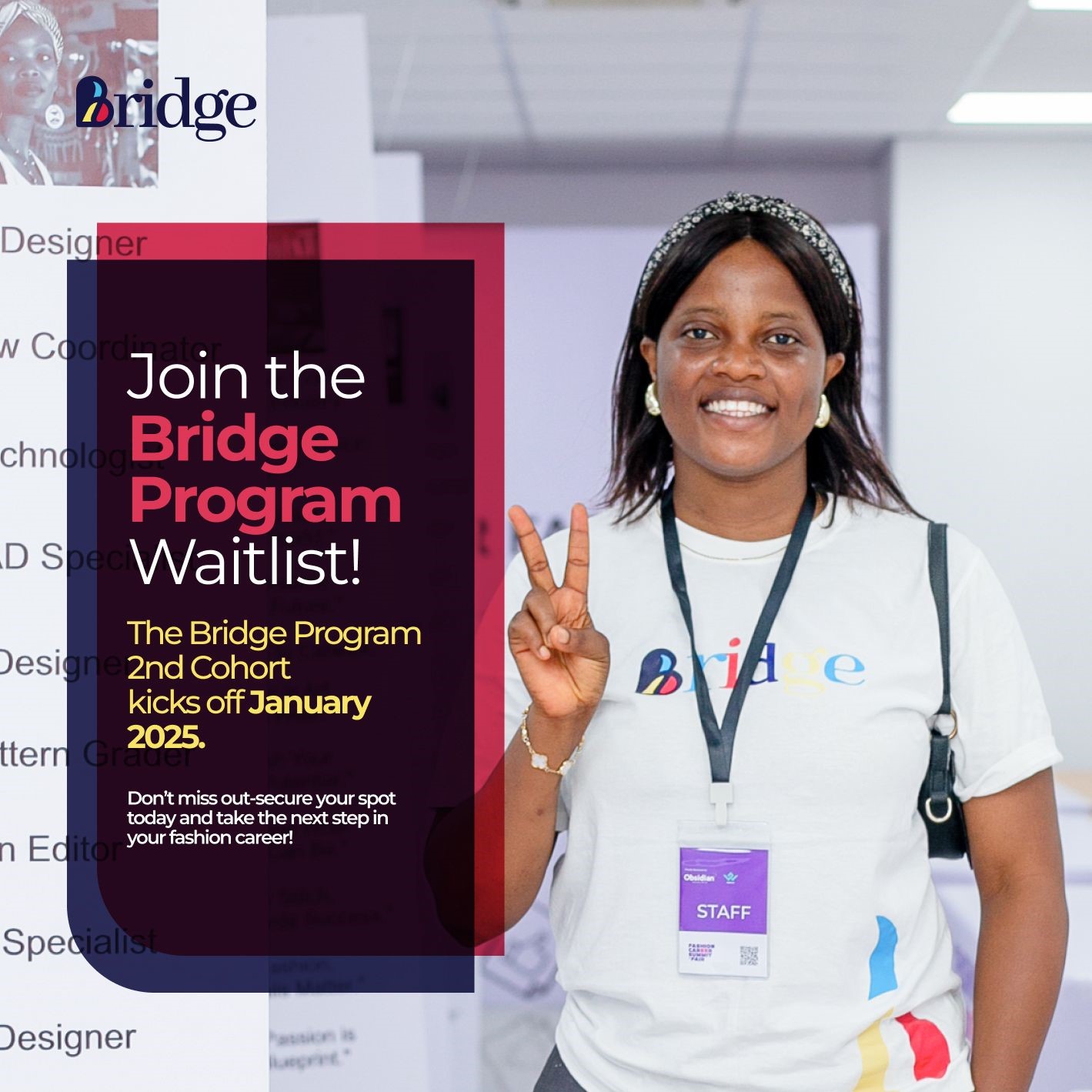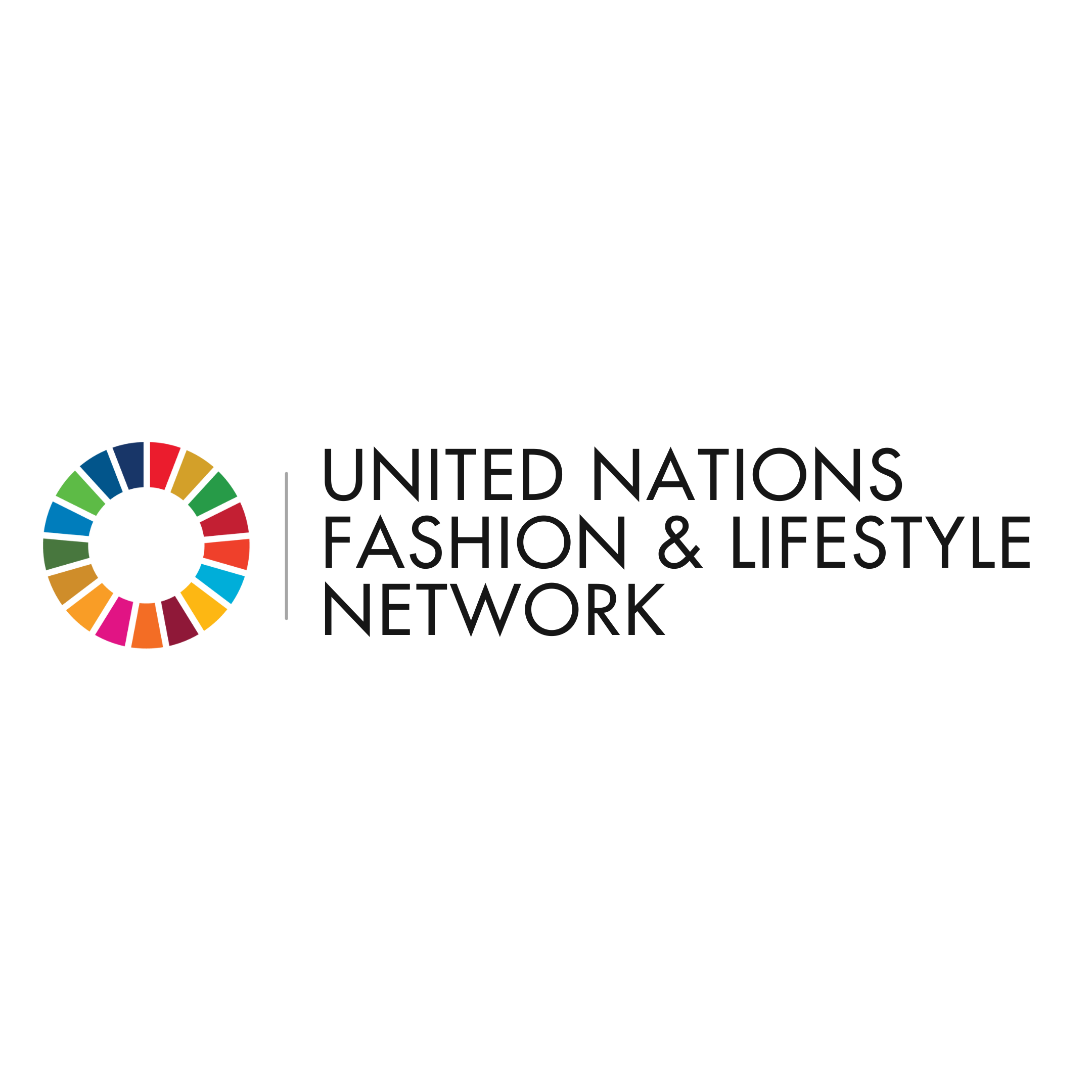Bridge Program
Obsidian Advisory Africa
(
Private sector
)
#SDGAction56722
Description
The Bridge Program aims to empower aspiring fashion professionals and entrepreneurs by providing them with comprehensive training, mentorship, and practical experiences that enhance their skills and employability in the fashion industry. The initiative is designed to achieve the following key objectives:
Skill Development: Equip participants with essential skills in fashion design, business management, marketing, and entrepreneurship through targeted workshops and courses. This comprehensive training ensures that participants are well-prepared to meet industry standards and expectations.
Access to Internships: Facilitate meaningful internship opportunities with established fashion companies, allowing participants to gain hands-on experience, build professional networks, and apply theoretical knowledge in real-world settings. This practical exposure is crucial for enhancing employability and fostering a deeper understanding of industry dynamics.
Industry Exposure: Organize field trips to prominent fashion companies and studios, enabling participants to observe and learn about the various facets of the fashion industry. These visits offer insights into current trends, production processes, and business operations, providing a holistic view of the industry landscape.
Mentorship and Networking: Connect participants with industry professionals and mentors who can provide guidance, support, and valuable industry insights. Building a robust professional network is vital for career advancement and accessing job opportunities.
Entrepreneurial Mindset: Foster an entrepreneurial spirit among participants by emphasizing the importance of innovation, creativity, and adaptability in the fashion industry. The program encourages participants to develop their own business ideas and prepares them for the challenges of entrepreneurship.
Sustainable Practices: Incorporate training on sustainable fashion practices, promoting environmental consciousness and ethical considerations in fashion design and production. Participants will learn about sustainable materials, eco-friendly production techniques, and the importance of social responsibility in the industry.
Evaluation and Continuous Improvement: Implement a feedback-driven approach to continually assess and refine the program’s offerings. By engaging participants in evaluation processes, the initiative can adapt to their needs and the evolving landscape of the fashion industry.
Program Structure and Duration: The Bridge Program is structured over 6 weeks, featuring a combination of in-person workshops, online classes, and hands-on training. The program is designed to accommodate various learning styles and schedules, ensuring inclusivity for participants from diverse backgrounds.
Engaging Learning Environment: The program creates an engaging and supportive learning environment where participants are encouraged to collaborate, share ideas, and learn from each other. Group projects, discussions, and peer reviews foster a sense of community and enhance the learning experience.
Collaborative Partnerships: The initiative actively seeks partnerships with fashion brands, educational institutions, and industry organizations. These collaborations facilitate resource sharing, enhance program credibility, and broaden the scope of learning opportunities for participants.
Practical Projects: Participants engage in practical projects that simulate real-world challenges in the fashion industry. These projects encourage creativity, problem-solving, and teamwork, allowing participants to apply their knowledge and skills in meaningful ways.
Guest Lectures and Industry Panels: The program regularly hosts guest speakers from various sectors of the fashion industry, providing participants with insights into different career paths and industry trends. Panel discussions allow participants to engage with industry leaders, ask questions, and gain valuable perspectives.
Evaluation and Assessment: Throughout the program, participants are assessed through a combination of practical assignments, project presentations, and feedback sessions. This evaluation process ensures that participants are meeting learning objectives and provides opportunities for personalized growth and improvement.
Post-Program Support: Upon completion of the program, participants receive ongoing support through alumni networks, career counseling, and job placement assistance. This post-program support is crucial for helping participants transition into the workforce and capitalize on the skills they have acquired.
Structured Curriculum: The Bridge Program features a comprehensive curriculum that encompasses various aspects of the fashion industry, including design, production, marketing, and business management. This structured approach ensures that participants acquire both theoretical knowledge and practical skills essential for success in their careers.
Workshops and Training Sessions: Regular workshops are organized, led by industry experts and seasoned professionals. These sessions cover a range of topics, such as digital marketing, fashion technology, sustainable practices, and entrepreneurial skills. By bringing in experts, participants gain exposure to cutting-edge techniques and trends, enhancing their ability to adapt to industry changes.
Internship Opportunities: The program prioritizes facilitating access to internships with reputable fashion companies. These internships are designed to provide participants with hands-on experience in real-world settings, enabling them to apply learned concepts in practical scenarios. The initiative actively partners with various fashion brands to secure placements for participants, fostering industry connections that may lead to future employment.
Field Trips and Industry Visits: Organized field trips to fashion companies, studios, and trade shows are a crucial component of the program. These visits allow participants to observe industry operations firsthand, engage with professionals, and gain insights into market trends and consumer behavior. Such exposure broadens participants' understanding of the industry landscape and enhances their practical knowledge.
Access to Technology and Resources: The program provides participants with access to the latest fashion design software, tools, and resources necessary for skill development. Workshops include training on fashion design software, pattern-making technologies, and e-commerce platforms, ensuring participants are equipped with relevant technical skills.
Networking Opportunities: The initiative hosts networking events and industry panels, connecting participants with fashion professionals, alumni, and potential employers. Building a robust professional network is essential for career advancement, and these events facilitate meaningful connections and collaboration within the industry.
Feedback Mechanisms: To ensure continuous improvement and relevance, the program implements regular feedback mechanisms. Participants are encouraged to provide input on their experiences, which is used to refine the curriculum, enhance training methods, and identify emerging industry needs.
The governance of The Bridge Program involves a structured framework to ensure effective coordination and implementation. Here’s a detailed description of the mechanisms in place:
1. Leadership Structure Steering Committee: A dedicated steering committee comprises representatives from Obsidian Advisory Africa, educational partners like the Director of Entrepreneurship and Skills Development Centre, University of Lagos, and industry professionals. This committee oversees the program's strategic direction, ensuring alignment with industry needs and participant goals.
Program Manager: A program manager coordinates day-to-day activities, manages logistics, and serves as the primary point of contact for participants and stakeholders.
2. Collaborative Partnerships Stakeholder Engagement: Regular meetings and workshops are held with all stakeholders to foster collaboration, share insights, and gather feedback. This ensures that the program remains responsive to the evolving needs of the fashion industry.
Advisory Panels: The program benefits from advisory panels composed of industry experts who provide guidance on curriculum development, training methodologies, and emerging trends in the fashion sector.
3. Operational Framework Training Teams: Specialized training teams consisting of experienced professionals in various aspects of fashion, business management, and entrepreneurship facilitate workshops and mentorship sessions.
4. Monitoring and Evaluation Continuous Assessment: The program employs ongoing monitoring mechanisms to evaluate participant progress and program effectiveness. This includes feedback collection through surveys, interviews, and focus groups to assess the impact of training sessions.
Impact Evaluation: Periodic evaluations are conducted to measure the program's success against its objectives, ensuring accountability and transparency in governance. This helps in identifying areas for improvement and scaling successful components of the initiative.
5. Communication Channels Information Dissemination: Clear communication strategies are established to keep participants and stakeholders informed about program updates, events, and opportunities. This includes newsletters, social media updates, and community meetings.
Feedback Mechanisms: Open channels for feedback allow participants to express their experiences, suggestions, and challenges faced during the program. This feedback is vital for program refinement and enhancing participant satisfaction.
Key Performance Indicators (KPIs): The Bridge Program establishes specific KPIs to measure the success of its initiatives. These include participant enrollment numbers, completion rates, and the percentage of participants securing internships or job placements after graduation. Monitoring these metrics provides quantifiable data on the program's effectiveness.
Participant Feedback Surveys: Regular surveys are conducted to gather feedback from participants on various aspects of the program, including curriculum effectiveness, instructor quality, and overall satisfaction. This qualitative data helps identify areas for improvement and allows the program to adapt to participants' needs continuously.
Skills Assessments: To gauge the acquisition of skills, the program implements assessments throughout its duration. Participants complete practical assignments, projects, and presentations that are evaluated against established rubrics. This evaluation not only measures individual progress but also informs curriculum adjustments based on common challenges faced by participants.
Employer Surveys and Feedback: The program collaborates with partner organizations and employers to gather feedback on the performance of participants who secure internships or job placements. This feedback provides insight into how well the program prepares participants for real-world challenges and can guide enhancements to training methods.
Longitudinal Tracking: After participants complete the program, the initiative tracks their career progression over time. This long-term data collection enables the program to assess its impact on participants’ career trajectories and economic mobility, providing a deeper understanding of its effectiveness.
Impact Reports: Comprehensive impact reports are generated periodically, summarizing findings from evaluations, participant feedback, and tracking data. These reports highlight success stories, challenges, and recommendations for future improvements, serving as a valuable resource for stakeholders and potential funders.
Educational Institutions, Alumni Networks (including Cheri Blaire Foundation EDC, Enterprise Development Center (Lagos Business School) Business Development Service Provider Associate (SMEDAN & EDC), Lhaude Africa Fashion Law Institute Nigeria,) Corporate Sponsors and Brands, Fashion Industry Associations
SDGS & Targets
Goal 4
Ensure inclusive and equitable quality education and promote lifelong learning opportunities for all
4.1
By 2030, ensure that all girls and boys complete free, equitable and quality primary and secondary education leading to relevant and effective learning outcomes
4.1.1
Proportion of children and young people (a) in grades 2/3; (b) at the end of primary; and (c) at the end of lower secondary achieving at least a minimum proficiency level in (i) reading and (ii) mathematics, by sex
4.1.2
Completion rate (primary education, lower secondary education, upper secondary education)
4.2
By 2030, ensure that all girls and boys have access to quality early childhood development, care and pre-primary education so that they are ready for primary education
4.2.1
Proportion of children aged 24–59 months who are developmentally on track in health, learning and psychosocial well-being, by sex
4.2.2
Participation rate in organized learning (one year before the official primary entry age), by sex
4.3
By 2030, ensure equal access for all women and men to affordable and quality technical, vocational and tertiary education, including university
4.3.1
Participation rate of youth and adults in formal and non-formal education and training in the previous 12 months, by sex
4.4
By 2030, substantially increase the number of youth and adults who have relevant skills, including technical and vocational skills, for employment, decent jobs and entrepreneurship
4.4.1
Proportion of youth and adults with information and communications technology (ICT) skills, by type of skill
4.5
4.5.1
Parity indices (female/male, rural/urban, bottom/top wealth quintile and others such as disability status, indigenous peoples and conflict-affected, as data become available) for all education indicators on this list that can be disaggregated
4.6
By 2030, ensure that all youth and a substantial proportion of adults, both men and women, achieve literacy and numeracy
4.6.1
Youth/adult literacy rate
4.7
By 2030, ensure that all learners acquire the knowledge and skills needed to promote sustainable development, including, among others, through education for sustainable development and sustainable lifestyles, human rights, gender equality, promotion of a culture of peace and non-violence, global citizenship and appreciation of cultural diversity and of culture’s contribution to sustainable development
4.7.1
Extent to which (i) global citizenship education and (ii) education for sustainable development are mainstreamed in (a) national education policies; (b) curricula; (c) teacher education and (d) student assessment
4.a
Build and upgrade education facilities that are child, disability and gender sensitive and provide safe, non-violent, inclusive and effective learning environments for all
4.a.1
Proportion of schools offering basic services, by type of service
4.b
4.b.1
Volume of official development assistance flows for scholarships
4.c
By 2030, substantially increase the supply of qualified teachers, including through international cooperation for teacher training in developing countries, especially least developed countries and small island developing States
4.c.1
Proportion of teachers with the minimum required qualifications, by education level
Goal 8
Promote sustained, inclusive and sustainable economic growth, full and productive employment and decent work for all
8.1
8.1.1
Annual growth rate of real GDP per capita
8.2
Achieve higher levels of economic productivity through diversification, technological upgrading and innovation, including through a focus on high-value added and labour-intensive sectors
8.2.1
Annual growth rate of real GDP per employed person
8.3
Promote development-oriented policies that support productive activities, decent job creation, entrepreneurship, creativity and innovation, and encourage the formalization and growth of micro-, small- and medium-sized enterprises, including through access to financial services
8.3.1
Proportion of informal employment in total employment, by sector and sex
8.4
Improve progressively, through 2030, global resource efficiency in consumption and production and endeavour to decouple economic growth from environmental degradation, in accordance with the 10-Year Framework of Programmes on Sustainable Consumption and Production, with developed countries taking the lead
8.4.1
Material footprint, material footprint per capita, and material footprint per GDP
8.4.2
Domestic material consumption, domestic material consumption per capita, and domestic material consumption per GDP
8.5
8.5.1
Average hourly earnings of female and male employees, by occupation, age and persons with disabilities
8.5.2
Unemployment rate, by sex, age and persons with disabilities
8.6
8.6.1
Proportion of youth (aged 15-24 years) not in education, employment or training
8.7
Take immediate and effective measures to eradicate forced labour, end modern slavery and human trafficking and secure the prohibition and elimination of the worst forms of child labour, including recruitment and use of child soldiers, and by 2025 end child labour in all its forms
8.7.1
Proportion and number of children aged 5‑17 years engaged in child labour, by sex and age
8.8
Protect labour rights and promote safe and secure working environments for all workers, including migrant workers, in particular women migrants, and those in precarious employment
8.8.1
Fatal and non-fatal occupational injuries per 100,000 workers, by sex and migrant status
8.8.2
Level of national compliance with labour rights (freedom of association and collective bargaining) based on International Labour Organization (ILO) textual sources and national legislation, by sex and migrant status
8.9
By 2030, devise and implement policies to promote sustainable tourism that creates jobs and promotes local culture and products
8.9.1
Tourism direct GDP as a proportion of total GDP and in growth rate
8.10
Strengthen the capacity of domestic financial institutions to encourage and expand access to banking, insurance and financial services for all
8.10.1
(a) Number of commercial bank branches per 100,000 adults and (b) number of automated teller machines (ATMs) per 100,000 adults
8.10.2
Proportion of adults (15 years and older) with an account at a bank or other financial institution or with a mobile-money-service provider
8.a
8.a.1
Aid for Trade commitments and disbursements
8.b
By 2020, develop and operationalize a global strategy for youth employment and implement the Global Jobs Pact of the International Labour Organization
8.b.1
Existence of a developed and operationalized national strategy for youth employment, as a distinct strategy or as part of a national employment strategy
SDG 14 targets covered
| Name | Description |
|---|
Deliverables & Timeline
Comprehensive Curriculum Guide: A detailed guide will outline training modules, learning objectives, and assessments for The Bridge Program, covering fashion design, entrepreneurship, and management skills.
Internship Placement Program: A structured program will connect participants with fashion companies for hands-on experience. Internships will be matched to skills, with certificates awarded for completion.
Alumni Network Platform: An online platform will connect alumni, offering job postings, mentorship, and networking events. Resources for continuous learning will be available to support their career growth.
Impact Assessment Report and Presentation: A comprehensive report will summarize achievements, outcomes, and lessons learned from each cohort, presented to stakeholders to highlight successes and secure future support.
Resources mobilized
Partnership Progress

Feedback
Action Network

Timeline
Entity
Region
- Africa
Geographical coverage
Other beneficiaries
Aspiring Fashion Professionals: The primary beneficiaries of The Bridge Program are aspiring fashion professionals, including students and recent graduates looking to enhance their skills and gain industry experience. The program equips them with the necessary tools to succeed in various roles within the fashion industry. Fashion Entrepreneurs: Individuals interested in starting their own fashion businesses benefit from the program's focus on entrepreneurship, strategic planning, and business management. Participants receive guidance on navigating the complexities of launching and sustaining a successful fashion brand.
Industry Partners and Employers: Organizations that collaborate with The Bridge Program also benefit from the initiative. By gaining access to a pool of skilled and motivated candidates, employers can enhance their workforce and foster innovation within their teams. Instructors: Professionals who serve as instructors gain personal satisfaction from contributing to the development of the next generation of fashion leaders. Their involvement allows them to give back to the community while refining their own leadership and teaching skills.
More information
Countries
Contact Information
Damilola Ademilokun, Founder

